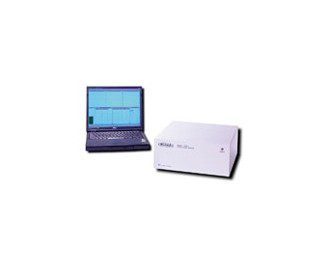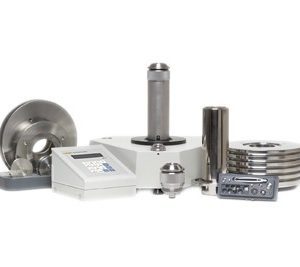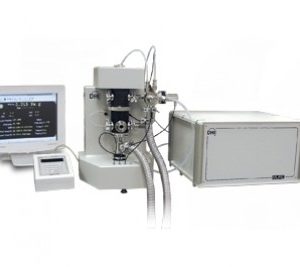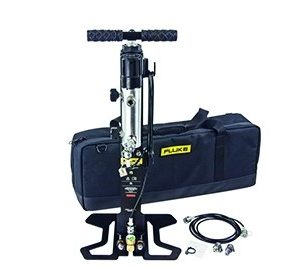Automates piston gauge calibrations
- Monitors critical piston gauge parameters
- Dual channel capability for cross float calibrations
- WinPrompt software is Windows based
- Use WinPrompt alone or in combination with Model 2456 PGM
- Export data to create customized calibration reports and certificates
- Automates piston gauge calibrations
- Monitors critical piston gauge parameters
- Dual channel capability for cross float calibrations
- WinPrompt software is Windows based
- Use WinPrompt alone or in combination with Model 2456 PGM
- Export data to create customized calibration reports and certificates
Accounting for environmental factors when performing piston gauge calibrations is an important but labor intensive process.
The Model 2456 piston gauge monitor (PGM) and WinPrompt calibration software help automate this process. The Model 2456 enhances measurement precision and consistency of critical piston gauge parameters including piston gauge temperature, float position, sink rate, air density, vacuum and other variables.
Temperature
The Model 2456 uses precision four-wire platinum resistance thermometers (PRTs) to monitor the piston gauge temperature. It actively monitors two PRTs and stores coefficients for up to ten. This minimizes the risk of damage to sensitive PRTs by allowing the operator to move the Model 2456 to another piston gauge location without moving the PRTs.
Float position
Non-contact, inductive proximity sensors in the Model 2456 accurately read the float position of the piston gauge to a resolution of 0.025 millimeters (0.001 inch), which is significantly greater than the readability of the unaided eye.
Sink rate
Sink rate is often used as an accurate indication of thermal stability, and for detecting leaks in the system that result in pressure measurement errors. In crossfloat applications, sink rate becomes a high resolution indicator of the differential pressure existing between two piston gauges. Routinely monitoring the sink rate of your piston gauge promotes consistency and confidence in your pressure calibrations. The sink-rate-versus- time display is vital for evaluating system integrity and stability.
Air density
The optional laboratory environment monitor (LEM) actively monitors relative humidity, barometric pressure, and ambient air temperature. The Model 2456 reads these signals and performs a real time computation of the density of the air surrounding the masses on the piston gauge. WinPrompt calibration software computes the buoyant effect of the ambient air on the piston gauge masses, and computes adjustments to the pressure or mass accordingly.
Vacuum module
The optional vacuum module is typically used with the Model 2465 gas piston gauge when operating in absolute mode and monitoring the residual bell jar pressure is required. The 2456 allows real time monitoring of the vacuum and is used with WinPrompt to make appropriate corrections to the pressure-mass calculations.
Units
Select from the following units of measurement:
- Temperature: ºC or ºF
- Float position: cm or in
- Barometric pressure: inHg, kPa, mbar, psi, kg/cm2, mmHg, or cmHg
- Vacuum: μHg or mTorr
- Density: g/cm3, kg/m3, lb/in3
- Sink rate: in/min or cm/min
WinPrompt calibration software
WinPrompt calibration software increases calibration efficiency by providing full-color, Windows-based measurement for your process. This easyto-use software can be used independently or in conjunction with the Model 2456. In either instance, WinPrompt provides the capability for customizing calibration procedures and reports.
Data storage
WinPrompt stores the calibration coefficients for your working standards, including piston/cylinder effective area, thermal coefficient of expansion, pressure deformation coefficients, and all calibrated mass values and associated density. It also stores all of the critical system and environmental parameters, including local gravity, head corrections, and air density.
Calculations and conversions
WinPrompt performs all necessary calculations of pressure-to-mass and mass-to-pressure in both metric and English units. When using the Model 2456 and the LEM, WinPrompt computes the buoyant effect of the ambient air on the piston gauge masses, and compensates accordingly.
Procedures
WinPrompt provides the ability to create calibration procedures for performing repetitive type calibrations. Multiple pressure values can be created in a table and each window (i.e. float position, temperature) can be sized, positioned and saved as a procedure. This can be recalled anytime the calibration is being performed.
Report formatting
Calibration reports can be exported in ASCII format and then imported into popular commercial spreadsheet and word processing software programs to generate customized, formal calibration reports. Set up your own calibration report templates in Microsoft Word®, Excel®, or other popular programs, adding your organization’s logo and other information to simplify and automate professional looking reports.
Accessory |
Description |
|---|---|
| WinPrompt | Calibration Software |
Product manuals
- RUSKA 2456 LEM Laboratory Environment Monitor Users Manual
- RUSKA 2456 Piston Gauge Monitor Users Manual
Data sheets
- 2456 WinPrompt Software Data Sheet English
- LEM Laboranzeiger Technische Daten German
- LEM Laboratory Environment Monitor Data Sheet
- WinPrompt Kolbenmanometer Monitor und Software Modell 2456 German
Request a quote - Shop




